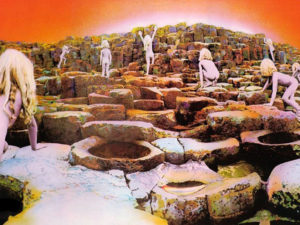Feature: ‘Houses Of The Holy’ by Led Zeppelin at 50
‘Houses Of The Holy’, the fifth studio album from classic rock overlords Led Zeppelin, is another incredible album turning 50 this year.
It was released 28 March 1973, mere weeks after Pink Floyd dropped their magnum opus ‘Dark Side Of The Moon’ in a stellar year for iconic rock albums.
Though vastly different in style and intent, both albums are the product of two already successful and popular bands reaching beyond themselves, channeling everything they’d so far achieved to create an everlasting record of their greatness.
On one hand, ‘Dark Side Of The Moon’ represents the pinnacle of concept albums, and on the other ‘Houses Of The Holy’ is a watershed album that marks Led Zeppelin shifting away from their well-established, bluesy hard rock sound.
Previous album ‘Led Zeppelin IV’ in 1971 had set a high standard for the band, featuring some of their catalogue’s most popular songs, like ‘Rock And roll’, ‘Black Dog’, ‘The Battle Of Evermore’ and their enduring signature epic ‘Stairway To Heaven’.
Thus far, Led Zeppelin had lent heavily on vocalist Robert Plant’s obsession with mysticism, the occult and the world of Tolkien in their songwriting that imbued it with dark overtones. In both its lyrics and overall sound, ‘Houses Of The Holy’ exists on a lighter and brighter creative plane, striking like the first warm rays of sunshine after a thunderstorm.
There was a greater sense of freedom in the recording process than previous albums as guitarist Jimmy Page and bassist John Paul Jones had installed home studios, allowing the band to explore new sonic terrain and develop more sophisticated arrangements without the constraints of traditional recording studios.
Having built a firm foundation on blues rock, Led Zeppelin expanded their musical palette broadly for ‘Houses Of The Holy’, incorporating elements of different genres such as reggae, funk and psychedelia while Page’s trademark heavy distortion gave way to clean, bright tones.
From the manic opening onslaught of track one ‘The Song Remains The Same’, it’s clear this is a Led Zeppelin album like no other, which only becomes more evident as side one rolls into one masterpiece after another: ‘The Rain Song’ (written after George Harrison complained to the band that they had no ballads), ode to the hippie lifestyle ‘Over The Hills And Far Away’, and ‘The Crunge’, a parody of James Brown deliberately written with a rhythm that is impossible to dance to.
Side two picks up on the joyously optimistic ‘Dancing Days’ before delving deep into reggae on ‘D’yer Mak’er’, which, much like ‘The Crunge’, was initially disregarded by critics as a derivative imitation but has become a quirky fan favourite over the years. But any notion of the band not taking the album seriously are quickly dismissed by the ethereal psychedelia of ‘No Quarter’. Composed by John Paul Jones, the song became a setlist standard and was performed at every show from 1973-1979. In closing track ‘The Ocean’, Led Zeppelin offer a love letter to their fans in a classic riff-driven song that is more reminiscent of the band’s earlier work.
As a transitional album, ‘Houses Of The Holy’ stands in contrast to all other Led Zeppelin albums for its experimental nature and the breadth of its influences. The album’s accompanying live tour cemented Led Zeppelin’s status as a stadium rock sensation and title of ‘the biggest band in the world’. ‘Houses Of The Holy’ would also be the last album to be released by Atlantic before the band established their own label Swan Song Records in 1974.

‘Houses Of The Holy’ inner gatefold.
‘Houses Of The Holy’ is the first Led Zeppelin album with an actual title and was also their first album sleeve to be designed by Hipgnosis, the same graphic studio behind the ‘Dark Side Of The Moon’ artwork.
The cover image was inspired by Arthur C. Clarke’s novel ‘Childhood’s End and was shot at Giant’s Causeway in Northern Ireland, with the inner gatefold photograph taken at nearby Dunluce Castle.
It depicts a group of naked children clambering over a geometric rock formation towards a spectacular new dawn. The shoot featured brother-sister child models Stefan and Samantha Gates and three adult models. The cover has been a source of controversy since its release for featuring child nudity, which on the original pressings was covered by a band of paper called an obi or Japanese kimono sash that had to be removed to access the vinyl.
Hipgnosis designers have stated that: “children were chosen to represent future innocent souls, nakedness to represent vulnerability”, mirroring the first steps Led Zeppelin were taking into the unknown with ‘Houses Of The Holy’, their own spectacular new dawn.
As transformational as ‘Houses Of The Holy’ was for the band, it was momentous and ultimately divisive for their fanbase. For some, it was a shameful abandonment of their hard rock roots; for others, it presented a transcendent new level of appreciation for Led Zeppelin.
At 50, ‘Houses Of The Holy’ remains as striking and vibrant as it did in 1973, having lost none of its energy or appeal over the years.
Become What You Are’, the new album from The Daisycutters is available now via MADCAP Global Music, JB Hi-Fi and independent music retailers.

